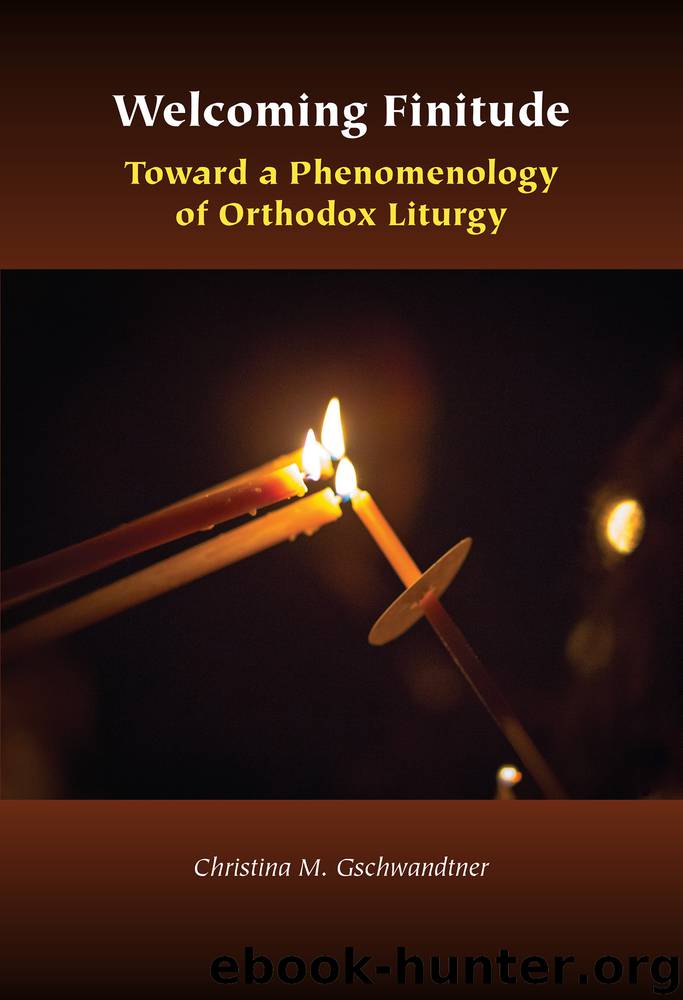Welcoming Finitude by Christina M. Gschwandtner;

Author:Christina M. Gschwandtner;
Language: eng
Format: epub
Publisher: Lightning Source Inc. (Tier 2)
Published: 2019-11-18T16:00:00+00:00
7
INTENTIONALITY
Phenomenology operates at the interplay between manifestation and intentionality. Now that it has been examined how liturgical experience is manifested in its temporality and spatiality, as well as in its corporeal, sensorial, affective, and communal dimensions, can anything be concluded about its overall intentionality? How are we directed to what is revealed to us within liturgy? What sort of intentionality is at work in it? Can liturgy be said to shape intentionality and, if so, how does it do so? What is ultimately “revealed” or “manifested” within liturgical experience?
The troparion for the feast of Theophany (the “phainesthai”—appearance or manifestation—of “theos”—God) affirms that on this day of the celebration of Christ’s baptism “the worship of the Trinity was made manifest” and that it “revealed” Christ as the Father’s “beloved son” who “appeared” in the world. Similarly, the troparion for the feast of the Annunciation speaks of it as “the manifestation of the mystery that was from eternity.” The transfiguration “shows” the disciples Christ’s “glory.” There are many similar claims made within liturgical texts about the revelation or manifestation of the divine. This question is also explicitly raised in the controversy over icons and thus becomes liturgically explicit in the liturgies for the Sunday of Orthodoxy (on the first Sunday of Great Lent), which celebrates the affirmation of icons as appropriate vehicles for divine manifestation. What is “revealed” or manifested in liturgy, at least according to the liturgical texts, is Christ’s glory or even the mystery of the Trinity. Liturgy is taken to be worship of God, encounter with the divine, manifestation of the kingdom of God.
At the same time, it is striking that all these revelations and manifestations remain mysterious and veiled in various ways. Even if we are said to encounter them “today” within the liturgy in some form, they are mediated to us via stories and images. In fact, the claims about revelation and manifestation are often highly qualified even within the liturgy itself. Both the troparion and the kontakion for Transfiguration, for example, affirm that the disciples only beheld Christ’s glory “as far as they could bear it,” acknowledging that it might not be possible to confront the divine fully or endure all of God’s manifestation directly. The controversy over icons ended up concluding that it was acceptable to portray images of the saints and of Christ, because they were human and incarnate beings who could be painted in material media, but that any veneration of them is directed beyond the visible and material to the invisible and immaterial. Our veneration is never of the wood or paint directly, but ascends to the “prototype” portrayed in the icon. Furthermore, a careful distinction was made between veneration (proskynēsis) and worship (latreia); while images of saints or Christ are venerated, only God is worshipped (the liturgical texts for the occasion emphasize this: “we depict the likeness of Thine outward form, venerating it with an honour that is relative” or “we shall glory in the ikon of the Word made flesh, which we venerate but worship not as an idol”1).
Download
This site does not store any files on its server. We only index and link to content provided by other sites. Please contact the content providers to delete copyright contents if any and email us, we'll remove relevant links or contents immediately.
| Amish | Catholicism |
| Christian Science | Jehovah's Witness |
| Mennonite | Messianic Judaism |
| Mormonism | Orthodoxy |
| Protestantism |
Under the Banner of Heaven: A Story of Violent Faith by Jon Krakauer(1687)
The Early Centuries - Byzantium 01 by John Julius Norwich(1655)
The Amish by Steven M. Nolt(1492)
Taken by J. C. Owens(1489)
In Spirit and Truth (In Spiritu Et Veritate Series) by Reed Zoe(1477)
Play It as It Lays by Joan Didion(1435)
The Apogee - Byzantium 02 by John Julius Norwich(1367)
The Last Man in Russia by Oliver Bullough(1325)
A History of the Amish by Steven M. Nolt(1217)
David Sedaris Diaries by David Sedaris(1168)
Leaving the Witness by Amber Scorah(1157)
Tears of the Silenced: A True Crime and an American Tragedy; Severe Child Abuse and Leaving the Amish by Misty Griffin(1145)
Fallen by unknow(1132)
The Dance of Change by unknow(1098)
The Angel of Forest Hill by Cindy Woodsmall(1083)
The Best of Amish Cooking by Phyllis Pellman Good(1079)
The Ariana Trilogy by Rachel Ann Nunes(1071)
Deep Blue by unknow(1063)
Escape by Carolyn Jessop & Laura Palmer(1055)
